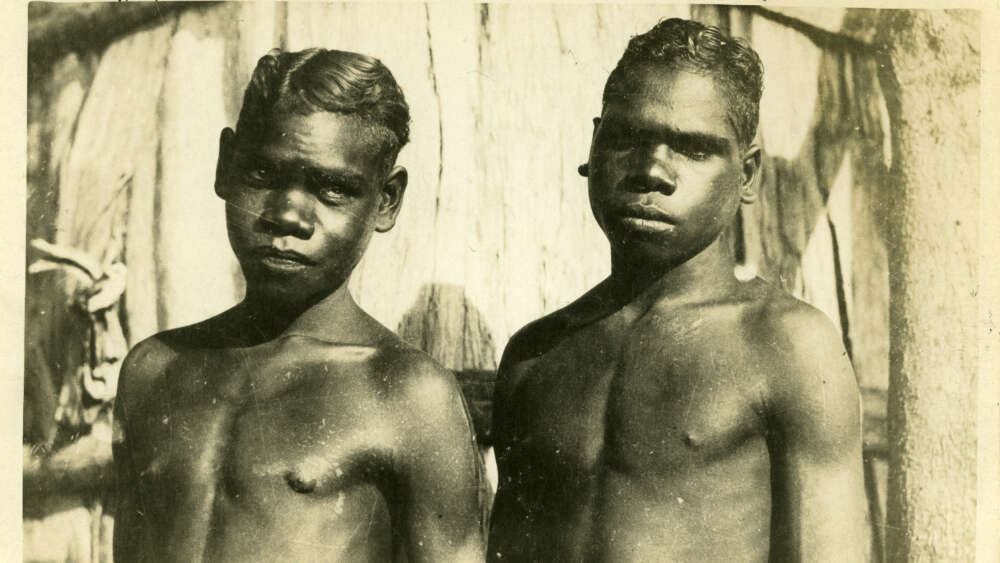The remote Arnhem Land Aboriginal settlement of Oenpelli, now called Gunbalanya, is said to be one of the most beautiful places on earth.
Certainly, Alf Dyer, the man who aimed to convert a buffalo shooting camp into a mission for the Church Missionary Society, thought so when he and his wife Mary, known as Katie, arrived there in 1925.
“Oenpelli is a very beautiful place surrounded by hills,” Dyer rhapsodised in his first report to CMS dated 21 September 1925.
“There are millions of birds feeding within the compass of a mile – thousands of ducks and pelicans are at our front door. Go for a walk and you see hundreds of wallabies; so the place abounds in native goods – I have seen no place in the North like it. The cattle around are feeding on lovely green grass – it does make pretty pictures wherever you look – a home for an artist! Dr. Jones and Professor Watson had plans of building a large place here for tourists – game, fishing, scenery and health, with the added attraction of the blacks.”
“It does make pretty pictures wherever you look – a home for an artist!” Alf Dyer
Dyer’s reports of his tumultuous six years as superintendent at Oenpelli form the backbone of a new book, The Bible in Buffalo Country: Oenpelli Mission 1925-1931, by Sally K. May, Laura Rademaker, Donna Nadjamerrek and Julie Narndal Gumurdul, which won this year’s Chief Minister’s History Award.
Drawing together documentary and photographic sources with local community memory, a story emerges of miscommunication, sickness, constant logistical issues, and an Aboriginal community choosing when and how to engage with the newcomers to their land.
“We survived the tough times and we are still strong as a community today.” – Julie Narndal Gumurdal
In her foreword to this fascinating record of mission, Traditional Owner Julie Narndal Gumurdul writes: “My clan are Mengerrdji-speaking people and our country spans well outside of the current Gunbalanya (Oenpelli) township. It is home to beautiful billabongs, floodplains and many stone outcrops such as Injalak and Arrkuluk Hill. These places have always been our home.
“Our recent history is complicated. Not all of it is nice to read about. But we survived the tough times and we are still strong as a community today,” she writes.
“My father – Nipper Marakarra Gumurdul – was the Senior Traditional Owner for Oenpelli during the time the first missionaries came … People still talk about him today. He was a serious but generous man. People say that he looked after people from other clans who came to live in Oenpelli. He allowed them to stay here, even though it was not their country. He was a tough leader and made difficult choices sometimes. When he thought the balanda [white people] were going too far, he took steps to control it. I guess he was a diplomat, but he did use force sometimes!”
In her introduction, co-author Laura Rademaker, a researcher at the Australian National University, explains that the book tells Aboriginal history even though it is seen through non-Indigenous eyes.
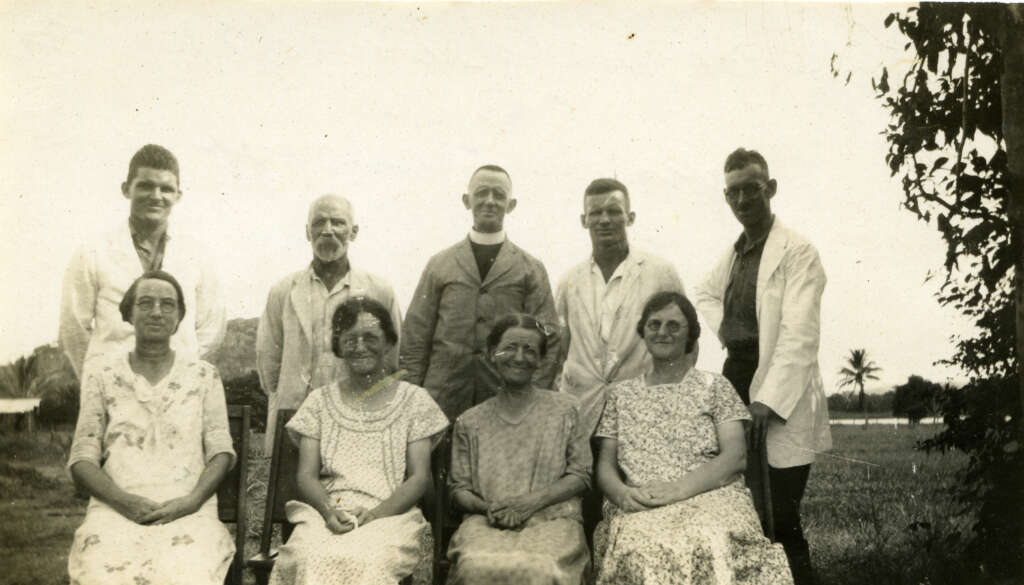
Staff of Oenpelli Mission, 1931
“I think the story is really one of resilience of Aboriginal people, the way Aboriginal communities were able to withstand so much change, the way Aboriginal people were able to take what was good in what colonisers offered and reject what they didn’t find useful, but were able to integrate changes into their community and reject the rest,” Laura tells Eternity.
“I think it tells a really complex story about the missionaries. I don’t like stories which had the missionaries as heroes or had the missionaries as villains; they are very complex people. They had a complex and sometimes contradictory agenda. I find that really fascinating.”
What follows are extracts from the introduction, and a report from Alf Dyer in 1930 which captures some of the missionaries’ blindness to Aboriginal experiences as they suffered from introduced diseases and worried about the safety of their children after a flood. It also describes, despite all this, some younger people expressing interest in Christianity and baptism.
The missionary intent
The Dyers had been missionaries in north Australia for decades when they arrived at Oenpelli, so they were not surprised that the daily experience of being a missionary was mostly just hard work. Still, they were not immune to disillusionment, nor to clashes with their colleagues. They also knew that it was unlikely Aboriginal people would flock to their mission or that they would see mass conversions rush through Arnhem Land (though they did record a number of baptisms). The work would be slow. They believed the mission would continue for decades before seeing its ‘fruit’. As ‘pioneer missionaries’ they were simply ‘sowing the seed’; later missionaries, they believed, would reap a Christian community in Arnhem Land.
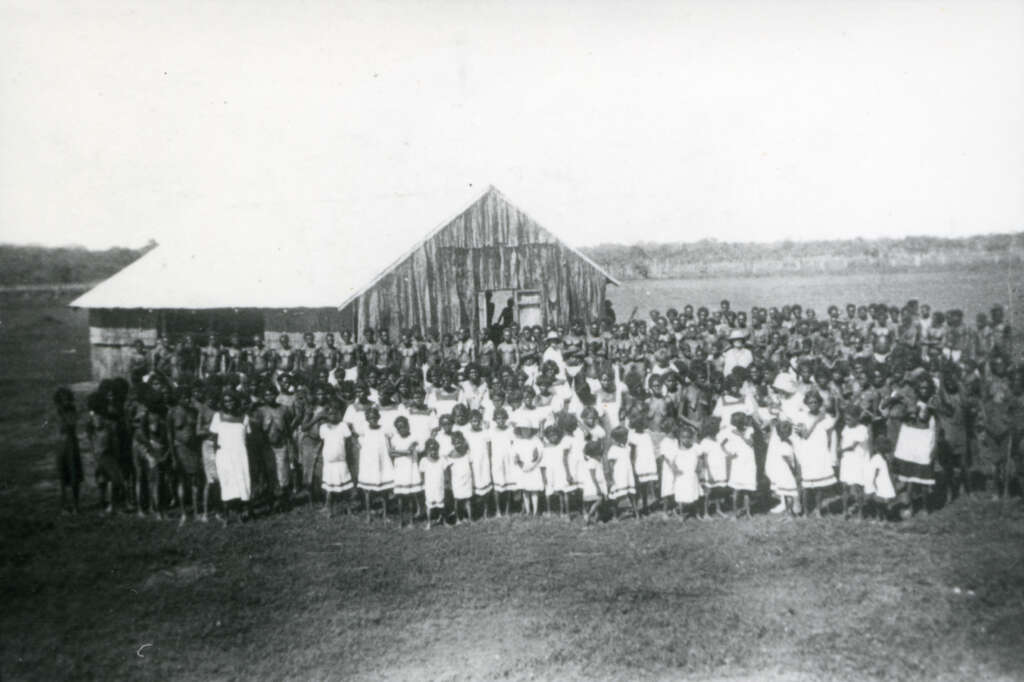
Group photo outside the new church (date unknown)
This future for Aboriginal people, they imagined, would be as an independent Christian people. Like many missionaries, they believed that contact with white Australia was fatal for Aboriginal people. So, at this stage, missionaries were not self-consciously seeking to assimilate Aboriginal people into white Australia (though, they did attempt to reform Aboriginal family life and culture to white norms, which was, of course, a form of assimilation). The sources here show that Dyer’s ambitions were broader than simply converting Aboriginal people to Christianity or providing humanitarian aid to the ‘remnant’ of the race. Dyer wrote of his dream of an ‘Arnhem Land State’, commenting that ‘a Native State is the only chance for these people’.
Through training Aboriginal people in pastoral work and agriculture, and by providing basic education, this state could be ‘self-supporting’. Christianity, too, was essential to such an enterprise; it supposedly provided Aboriginal people with the moral fortitude and wisdom to resist temptations introduced by whites: alcohol, gambling and interracial sex …
The need to negotiate
As much as the missionaries dressed up their work in pious rhetoric, these sources show they had two main strategies for attracting people to the mission: tobacco and education of children. The letters reveal Dyer’s calculus of exactly how much tobacco would be needed to attract workers to the station. He wanted to give out as little as possible and had mixed feelings about addiction. ‘I hate the stuff’, he wrote. Evangelicals did not smoke. The missionaries did use large Christmas banquets to attract people to the mission. But a general food ration did not work; the community could feast on ducks, wallabies, fish and fruit whenever they wanted, why would they want missionary food?…
The main reason the mission needed to produce food was to fuel its other strategy for attracting people to the mission: the education of children. …
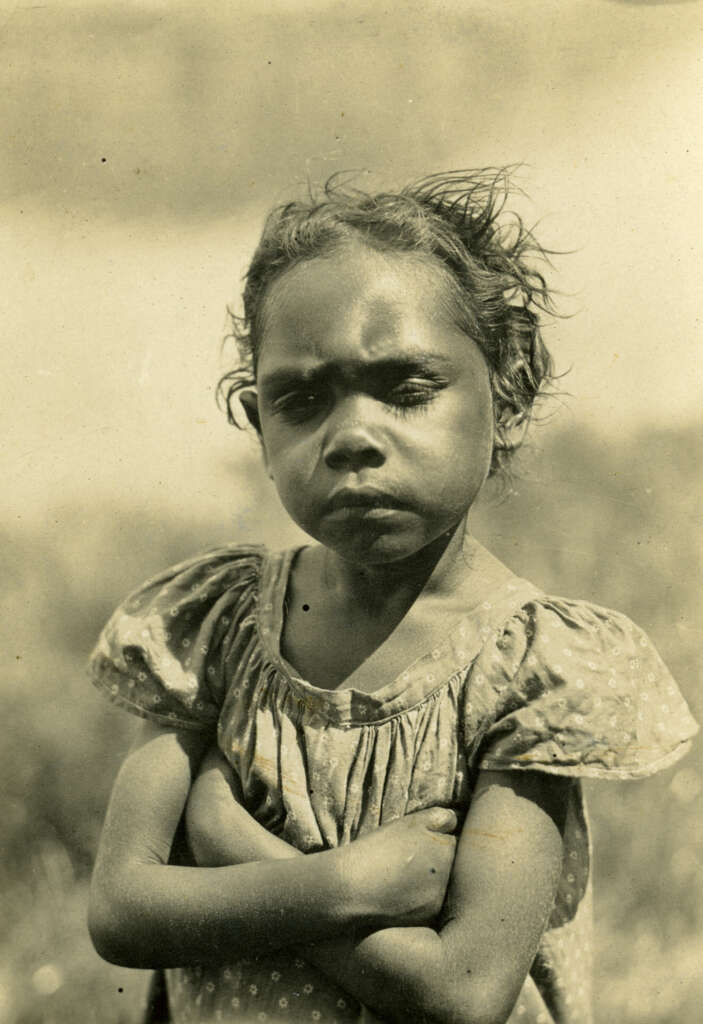
Young girl, date unknown
It was very important to the Oenpelli community that their children learn to speak, read and write in English … It was not that local people did not value their own languages or traditions around communication. They were already familiar with the benefits of being multilingual for negotiating with other groups (Arnhem Land being highly multilingual). So they quickly saw that adding English literacy to their existing linguistic repertoire would give their children an edge when negotiating with (or outsmarting) colonisers in the future … It is also likely the community wanted their children to know something of the missionaries’ spiritual knowledge. The missionaries seemed endowed with material wealth and power – knowing the source of their power might also be useful…
Those whose children were held in the dormitory camped at the mission to keep an eye on their children’s wellbeing. So when a flood hit the mission in 1930, families rushed into the mission to ensure their children were safe. The proximity of families suited the missionaries too; children were like a magnet, keeping the community within missionaries’ sphere of influence. So many came that the mission sometimes struggled to provide work and food for them.
Report from 1930
So far 1930. has brought to us many troubles, 15 acres of new garden has been grubbed & some trees that were on the old camp sites were sacred trees in which spirits lived, I was not informed of this till they were down & about to be burnt, then they asked me not to burn them there as some would die, I respected their wishes & burnt them further away. At Xmas whooping cough developed & they all got it & it lasted till April, the ladies had a very anxious time & several babies died, also others out bush, the camp people were most difficult to help. The fault generally was their own ideas about sickness & some said our medicines were poisonous, & refused to come for them, they had firmly fixed in their minds that the trees chopped down would cause death, one night they went out with fires to chase the spirits away, – these people lie down o[n] things quickly & will not move to help themselves. Some of the dormitory girls were very sick with malaria & other troubles, they were most difficulty to help & not a smile only whine all the time, & did not seem to care if they lived or died, they were deep down in the valley of the shadow. Carabumba who was married last year had a bonny baby just before she took it whooping cough, the baby died. I was coming back from burying one child & she died in our house before my return, we had prayer with them & tried to comfort them.
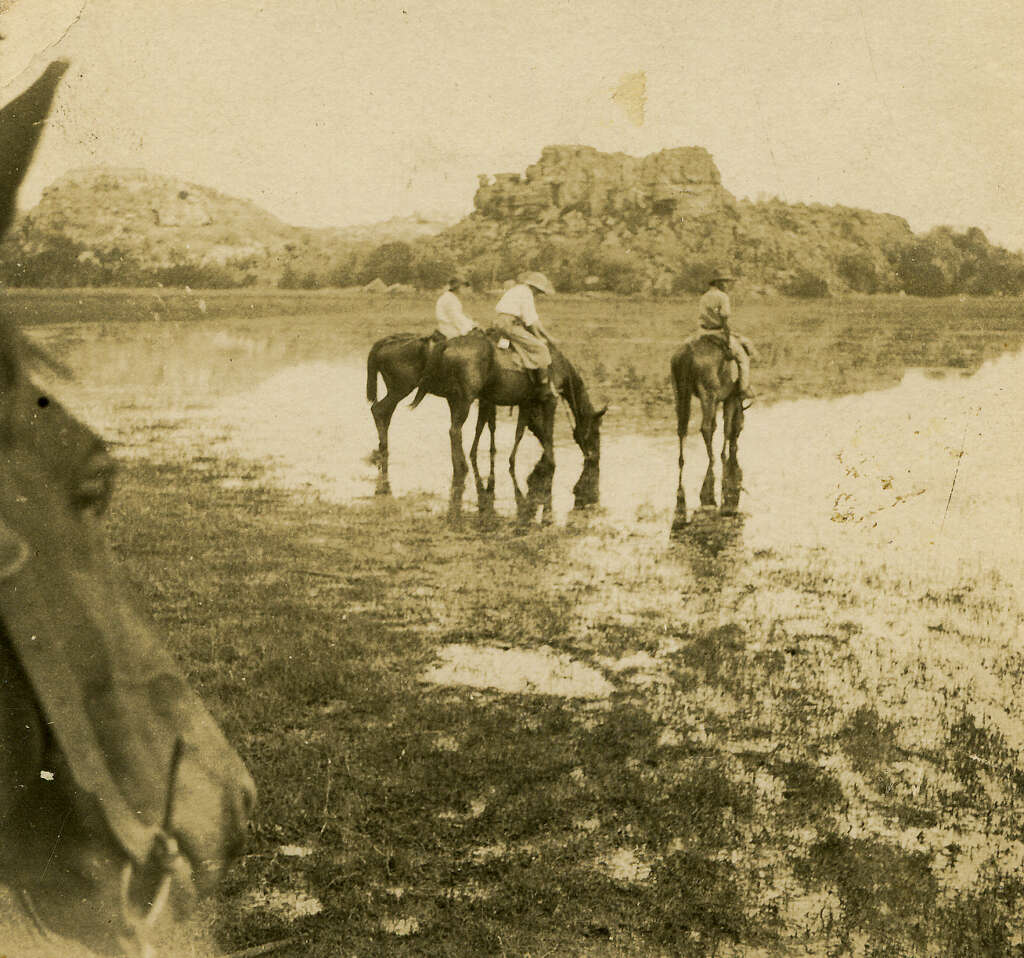
Visit to Red Lily billabong (date unknown)
I told them to get her ready for burial in the afternoon, the grandfather took her & wanted to put her up a tree with native rites. We waited half an hour at the grave, no sign of them coming, so guessing a hitch I went to see what could be done & plead for a decent burial for the little one, like Michael, over the body of Moses won. Then the big floods came right through the house & practically destroying all the food in our gardens, all our hard work to grow plenty all gone. Great excitement happened the night of the big waters, the blacks rushed up to carry away their children, we had them all safe, it was very funny to see them peering into the empty dormitories, they were in Miss Sherrin’s house which was higher, some were carried to the camps, Carabumba among them & there she wanted to stay so she could dodge taking medicine. I went & brought her back, but again she went to camp, by this time she had lost over two stone & had to be brought back again & forced to eat & be cared for, at times before this there had been indications of a desire for a higher life, but seemed lost. At last the whoops weakened & she grew stronger, & now she has come to ask for baptism[;] a very real change has come over her, with her came 6 others. Elwyndiwyndi, a little tartar, the ladies were almost in despair with the cheek & disobedience, constant punishing seems to make no difference, at times it seemed real demon possession, I told them all publicly that we would not take cheek from anyone, it either meant obedience or go & cheek the trees as much as they liked, one or two women paid the penalty, but the grace of God is the only real remedy.
To this end we decided to spend Good Friday after the people’s service as a day of prayer and meditation on the Cross, our prayers to be definitely confined to our people, women & girls in the morning, men & boys in the afternoon, all being mentioned by name, & before we had all met together fo[r] our weekly prayer meeting again, which was because we were separated, the answer had come. This child since coming to ask for baptism had been like an angel, most willing & faithful, others too, some of the others are younger & probably come because of the others, but time proves all things, there names are– Carabumba, Elwyndiwyndi, Elmynjalinmag, Garijala, Galinower, Jaragalgal, Garynjulu. We see many changes in the older ones, but these young ones may help them to come out especially if they remain faithful. Will you help them & us in your prayer.
Alf Dyer
The Bible in Buffalo Country: Oenpelli Mission 1925-1931 by Sally K. May, Laura Rademaker, Donna Nadjamerrek and Julie Narndal Gumurdul is published by ANU Press.
Email This Story
Why not send this to a friend?
